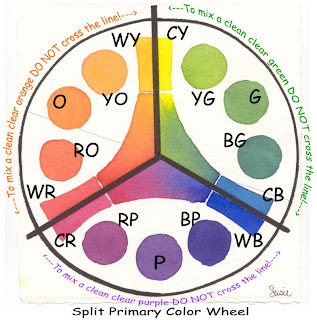QUESTION: Susie, I was looking for watercolor palette suggestions and found your website. You mention a split primary palette. Would you please explain what a split primary palette is, what colors I need and how to use it? Much thanks for all your help! Judy S. Texas
SUSIE'S REPLY: Hi Judy! Here's what I refer to as a Split Primary Palette
Use a warm and a cool of each primary hue (a warm red and a cool red; a warm yellow and a cool yellow; a warm blue and a cool blue) to mix bright, high-intensity primary called a Mixed Primary Hue. The secret is in using the right split primary colors and not crossing over the lines into another section!
Use a warm and a cool of each primary hue (a warm red and a cool red; a warm yellow and a cool yellow; a warm blue and a cool blue) to mix bright, high-intensity primary called a Mixed Primary Hue. The secret is in using the right split primary colors and not crossing over the lines into another section!

Here's how the Split Primary Palette works:
Let's start with a color wheel arranged like a clock (illustration above) and divided into three equal sections. At the top of the wheel (12 o'clock) a cool yellow, like Hansa Yellow Medium -- a lemony, slight bias to blue-green is on the right of the line; a warm yellow, like New Gamboge -- a golden, slight bias to red-orange is on the left of the line. Going clockwise around the circle (at 4 o'clock) there is a cool blue, like Phthalo Blue (GS) -- an icy, slight bias to blue-green is above the line; a warm blue, like French Ultramarine -- a purplish blue, slight bias to violet is below the line. Continuing clock wise, (at 8 o'clock) a cool red, Quinacridone Rose -- a rosy, slight bias to red-violet is below the line; a warm red, Pyrrol Scarlet -- a tomatoey red, slight bias to red-orange is above the line.
To mix the oranges, mix the red and yellow within the lines to the left of the circle. First mix orange, and then add more yellow for yellow-or ange and more red for red-orange.
To mix the greens, mix the blue and yellow within the lines to the right of the circle. First mix green (2 o'clock), and then add more yellow for yellow-green (1 o'clock) and more blue for blue-green (3 o'clock).
To mix the purples or violets, mix the pink or rose with the blue within the lines at the bottom of the circle. First mix purple (6 o'clock), and then add more blue for blue-violet (5 o'clock) and red for red-violet (7 o'clock).
Now here's the rule that makes this theory work: When mixing two colors on the wheel to achieve high-intensity color, don't cross over the line/stay in each section. Crossing over the lines and mixing the colors on either side of the line causes the mixtures to become less intense and slightly grayer. Cross two lines and even more graying occurs. This graying is called neutralizing. It is the result of a slight touch of that third color being added to the mix.
Hint: To mix earth colors, you simply cross over the lines or add a warm neutral to your mixtures. That's where Quinacridone Burnt Orange -- the seventh color of our essential 7 basics-enters the scene... it's a versatile warm neutral.
You have several good choices for professional artist grade watercolors to choose from.
My palette is currently filled with Daniel Smith Extra Fine Watercolors.
Materials List for Susie's Split Primary Palette
DANIEL SMITH Extra Fine Watercolors
Seven 15ml Tubes - Essential Set offered by Daniel Smith at 40% off regular tube price)
Set contains:
Hansa Yellow Medium
New Gamboge
Phthalo Blue (GS)
French Ultramarine
Quinacridone Rose
Pyrrol Orange
Quinacridone Burnt Orange
Thanks for your questions Judy! Have fun painting and mixing up pretty colors!
SUSIE
For more information about Color check out Nita Leland's book EXPLORING COLOR
and her latest release CONFIDENT COLOR
No comments:
Post a Comment